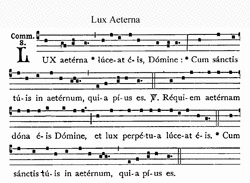Lux Aeterna
for Brass Quintet*
*Looking for the wind ensemble version of this work? Click here.

Lately, the subject of light has been prevalent in my music. This phenomenon occurred largely by chance, and each piece dealt with light through multiple religious and philosophical approaches. This initiated some extended thought on the nature of light and darkness, and how they are not only opposites, but define each other. Darkness is the absence of light, and vice versa. The philosophy of yin and yang shows us that these opposing forces are also interconnected and interdependent. In a lit room, there are shadows. Light can peak through a window or under the door of a darkened room.
In Lux Aeterna, a more religious tradition of light is explored through the use of the Gregorian chant of the same name from the Requiem Mass. Those familiar to the Requiem Mass know of its own dual nature. Prayers for comfort, peace, and eternal rest are juxtaposed with vivid cries for salvation from cruel and eternal damnation, not just for the dead, but for the living as well. The product is a much more surreal (and perhaps more accurate) portrayal of the emotions surrounding the death of a loved one, a portrayal completely alien to most modern funeral rites which emphasize comfort and hope over the fear and despair that may actually accompany death.
Lux Aeterna is a fantasy on the Lux Aeterna chant, first presenting the theme in a quasi-mensuration canon, followed by a number of permutations of it throughout the work. The reverent chant becomes a hopeful hymn, a joyous celebration, a sinister dance, a malicious taunt, and even morphed into the familiar and fearful Dies Irae motive. However, throughout these moods, whether light or dark, the opposite force is also present, illustrating my view that nothing is pure good or evil, light or dark, only a shade in this wide spectrum.
In Lux Aeterna, a more religious tradition of light is explored through the use of the Gregorian chant of the same name from the Requiem Mass. Those familiar to the Requiem Mass know of its own dual nature. Prayers for comfort, peace, and eternal rest are juxtaposed with vivid cries for salvation from cruel and eternal damnation, not just for the dead, but for the living as well. The product is a much more surreal (and perhaps more accurate) portrayal of the emotions surrounding the death of a loved one, a portrayal completely alien to most modern funeral rites which emphasize comfort and hope over the fear and despair that may actually accompany death.
Lux Aeterna is a fantasy on the Lux Aeterna chant, first presenting the theme in a quasi-mensuration canon, followed by a number of permutations of it throughout the work. The reverent chant becomes a hopeful hymn, a joyous celebration, a sinister dance, a malicious taunt, and even morphed into the familiar and fearful Dies Irae motive. However, throughout these moods, whether light or dark, the opposite force is also present, illustrating my view that nothing is pure good or evil, light or dark, only a shade in this wide spectrum.